Kosher ice cream offers you a tasty way to enjoy dessert while adhering to dietary laws. Each brand must receive certification ensuring that all ingredients and production methods comply with kosher standards. Look for recognizable symbols like OU, OK, or Star-K on the packaging for assurance. Popular brands like Ben & Jerry's and So Delicious provide a range of kosher options, including dairy-free choices. The demand for kosher ice cream is rising, leading to exciting flavors and accessible options in stores. Keep exploring to discover more about the various brands and what sets them apart in the kosher ice cream market.
Key Takeaways
- Kosher ice cream requires certification to ensure compliance with Jewish dietary laws, preventing cross-contamination with non-kosher ingredients.
- Reliable kosher certification symbols include OU (Orthodox Union), OK, and Star-K, indicating adherence to kosher standards.
- Popular kosher ice cream brands include Ben & Jerry's, Haagen-Dazs, and So Delicious, which offer a variety of flavors.
- The certification process involves thorough ingredient reviews and regular inspections by rabbinic authorities for ongoing compliance.
- Consumer awareness of labeling and certification is crucial, as not all natural or organic products are kosher-certified.
Understanding Kosher Ice Cream
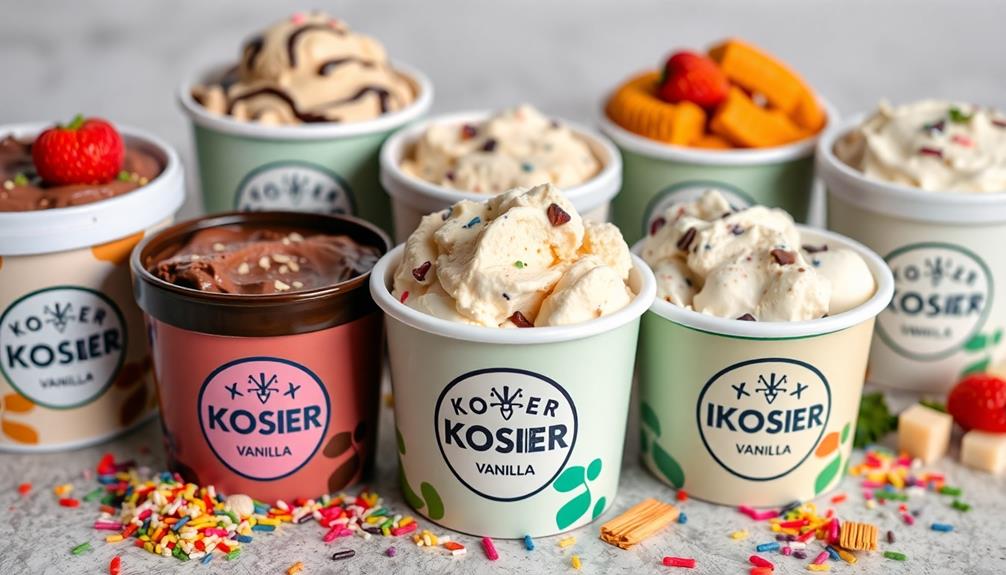
Understanding kosher ice cream starts with knowing the importance of ingredients and production methods. To guarantee your ice cream meets kosher standards, it's essential to use kosher-certified ingredients. Be mindful that common non-kosher components, like certain stabilizers and emulsifiers, need verification for their kosher status.
When it comes to dairy ice creams, supervision is necessary to prevent any mixing with meat products, adhering to kosher laws. If you prefer pareve varieties, they also require certification to avoid cross-contamination with non-kosher items.
To ensure compliance, look for reliable kosher certification symbols such as OU, OK, and Star-K on the packaging. These symbols assure you that the product aligns with kosher guidelines, giving you peace of mind while indulging.
Brands like Ben & Jerry's and Haagen-Dazs offer select flavors that proudly carry kosher certification, catering to your needs as a kosher consumer.
Key Ingredients for Certification
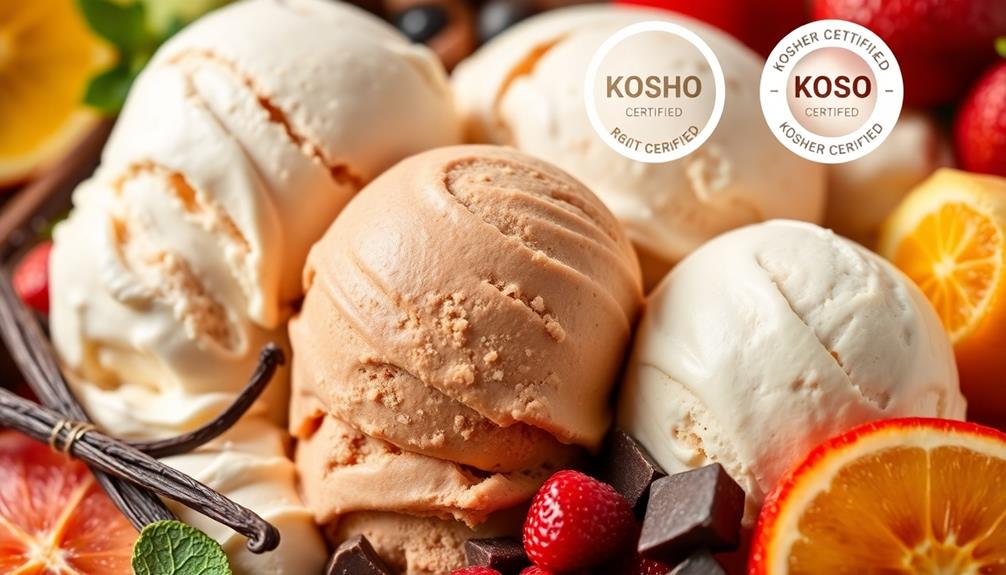
When you're choosing kosher ice cream, you need to pay attention to the ingredients.
Each component must be kosher-certified, meaning it meets specific dietary laws and comes from approved suppliers.
Understanding the certification process helps guarantee that what you're enjoying aligns with kashrut standards.
Essential Ingredient Requirements
Kosher ice cream almost always includes ingredients that are certified kosher, ensuring adherence to kashrut. To meet these standards, the dairy used must come from kosher animals.
You'll find that common components like milk, cream, sugar, and flavorings must be free from non-kosher additives, which can include certain stabilizers and emulsifiers.
When it comes to flavorings and mix-ins, such as chocolate, they also need to be sourced from kosher-certified suppliers. This means you can enjoy your favorite flavors without worrying about compliance with dietary laws.
Additionally, if you prefer alternative milks, like almond or soy, these too must carry a kosher certification to meet your dietary requirements.
It's also critical that the equipment used in producing kosher ice cream is kosher and properly kosherized. This helps prevent any cross-contamination with non-kosher items, ensuring that every scoop is compliant.
Certification Process Overview
Typically, the certification process for kosher ice cream involves a thorough examination of all ingredients to confirm they meet kosher standards. This means that every component, including stabilizers and emulsifiers, must be verified for kosher status by a certified authority.
You should know that the equipment used in producing kosher ice cream also plays an essential role. It must be kosher and completely free from any cross-contamination with non-kosher products.
Regular inspections and audits by the certifying agency guarantee compliance with kosher standards throughout the entire production process. This vigilance helps maintain the integrity of the kosher designation.
When you're shopping, look for products that display a recognized kosher symbol, known as a hechsher, on their labeling. This symbol assures you that the ice cream adheres to kosher laws.
Bear in mind that certification can vary depending on the region and type of product. Specific guidelines exist for dairy and pareve ice creams to prevent any meat contamination, confirming that you can enjoy your treats while staying true to kosher practices.
Certification Process Explained
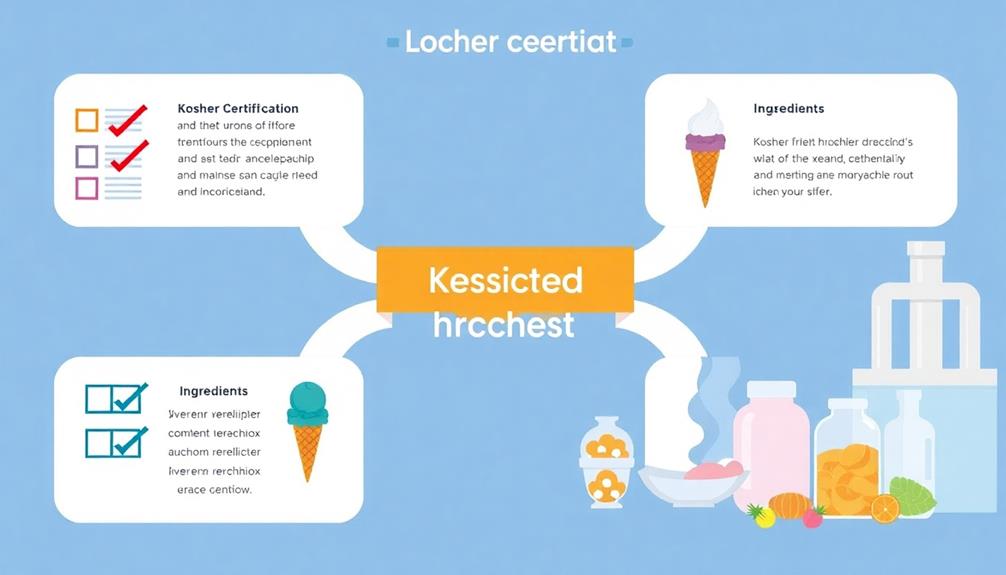
When you're looking for kosher ice cream, understanding the certification process is key.
You'll find that a certification authority plays a crucial role in ensuring each product meets strict inspection and compliance standards.
Plus, recognizing the importance of labeling and the kosher symbol can help you make informed choices.
Certification Authority Overview
The kosher certification process is essential for guaranteeing that ice cream brands meet the dietary laws of kashrut. This process is overseen by reliable authorities, such as the Orthodox Union (OU) or OK Kosher, who ensure that both ingredients and production practices align with kosher standards.
Here's how the certification process typically works:
- Application Submission: Brands seeking certification must submit a formal application to the certifying authority.
- Guidance from a Rabbinic Coordinator: A Rabbinic Coordinator (RC) is assigned to guide the brand through compliance with kosher requirements.
- Thorough Review: The authority conducts a detailed review of ingredients, facilities, and equipment to prevent cross-contamination with non-kosher substances.
- Labeling: Once certified, products display a recognized kosher symbol (hechsher) on their labels, ensuring consumers of adherence to kosher standards.
Regular inspections and audits are also part of the process, guaranteeing ongoing compliance and maintaining the integrity of kosher products.
This rigorous approach provides you with the confidence that your ice cream choices are truly kosher.
Inspection and Compliance Standards
Ensuring that ice cream meets kosher standards involves a meticulous inspection and compliance process that you can trust. When a manufacturer seeks kosher certification, they work closely with a reliable rabbinic authority. Each application is assigned a Rabbinic Coordinator who guides you through the entire compliance process, ensuring every ingredient and production method aligns with kashrut laws.
Regular audits and inspections are essential in this process. These checks help maintain adherence to kosher standards, verifying that no non-kosher substances have slipped into the final product. This commitment to quality not only reinforces kosher compliance but also fosters consumer confidence.
Transparency is key in the compliance process. You can feel assured knowing that the ingredients used are accountable and clearly listed. This dedication to ingredient integrity is vital for building trust in kosher products.
Once all standards are met, certification symbols like OU or OK are displayed on packaging. These symbols serve as a reliable assurance that what you're buying is indeed kosher.
With this rigorous process in place, you can indulge in kosher ice cream with peace of mind.
Labeling and Symbol Importance
Understanding the importance of labeling and certification symbols is key for anyone looking to purchase kosher ice cream. These symbols, such as OU, OK, and Star-K, indicate that a product meets kosher standards.
Here's what you should know about the certification process:
- Comprehensive Inspections: Certification involves thorough audits of production facilities to guarantee they adhere to kosher laws.
- Ingredient Verification: All ingredients must be verified for kosher status; using non-kosher additives can disqualify the product.
- Regular Monitoring: A rabbinic authority continually monitors production to guarantee equipment remains kosher and free from cross-contamination.
- Label Scrutiny: Always read labels carefully. Understanding certification symbols helps you make informed choices about which kosher ice cream to buy.
Popular Kosher Ice Cream Brands

When it comes to satisfying your sweet tooth while adhering to kosher dietary laws, several popular ice cream brands stand out.
Ben & Jerry's offers a delightful selection of kosher-certified flavors, so you can indulge without worry. If you're after premium ice cream, Haagen-Dazs provides kosher options in select markets, ensuring you enjoy their rich textures while observing kashrut.
For those who prefer dairy-free choices, So Delicious specializes in kosher ice cream that caters to lactose intolerance and vegan diets, making it a great option for everyone.
If you're looking for variety, Dreyer's/Edy's features select kosher-certified flavors, expanding your options for delicious treats.
Don't overlook Gelato Fiasco, which offers a range of kosher-certified gelato varieties. This brand appeals to anyone craving gourmet kosher desserts with unique flavors.
Whether you're a fan of classic ice cream or adventurous gelato, these brands provide a tasty way to enjoy your favorite frozen treats while adhering to kosher standards.
Market Trends in Kosher Ice Cream

You'll notice a growing consumer demand for kosher ice cream, driven by a wider interest in dietary restrictions and preferences.
As brands innovate with bold flavors and high-quality ingredients, the market is evolving to meet diverse tastes.
This trend not only enhances your options but also reflects the increasing accessibility of kosher ice cream in mainstream stores.
Growing Consumer Demand
The growing demand for kosher ice cream reflects a significant shift in consumer preferences, with more people actively seeking products that adhere to Jewish dietary laws. This trend isn't just limited to traditional kosher options; it encompasses a variety of products appealing to diverse dietary needs.
Here are four key factors driving this demand:
- Dairy-Free and Vegan Options: The rise in awareness of dietary restrictions has led to an expansion of dairy-free and vegan kosher ice cream, catering to those with lactose intolerance or vegan lifestyles.
- Gourmet and Artisanal Brands: Consumers are increasingly gravitating towards gourmet and artisanal kosher ice cream brands, attracted by unique flavors and high-quality ingredients that enhance their dessert experience.
- Mainstream Availability: Major grocery stores are now stocking a wider range of kosher ice cream, making these products more accessible to a broader audience, whether they observe kosher laws or not.
- Focus on Labeling and Certification: There's a heightened awareness regarding labeling and certification, ensuring that kosher ice cream meets consumer expectations for compliance and quality.
This growing interest highlights the importance of quality and choice in today's market.
Innovations in Flavors
Innovations in flavors are transforming the kosher ice cream landscape, enticing consumers with unique combinations that go beyond traditional offerings.
You'll find gourmet and artisanal flavors on the rise, catering to those who seek exceptional taste experiences while adhering to dietary laws. Brands like Ben & Jerry's and Haagen-Dazs are leading the charge, incorporating trendy ingredients like matcha and superfoods into their kosher-certified lines.
The surge in plant-based ice creams is another exciting trend. Brands such as So Delicious are now offering dairy-free kosher options, attracting vegan consumers who want to indulge without compromising their values.
Seasonal and specialty flavors are gaining popularity too, often requiring additional kosher certification to guarantee compliance during production.
The growth of online shopping has also played a significant role in expanding the kosher ice cream market. It allows niche brands to reach a broader audience, providing access to innovative flavors that meet kosher standards.
With these exciting advancements, the kosher ice cream market is sure to delight your taste buds and keep you coming back for more unique experiences.
Health Benefits of Kosher Ice Cream

When it comes to indulging in a sweet treat, kosher ice cream offers notable health benefits that can enhance your dessert experience. By choosing kosher, you often enjoy higher-quality ingredients, free from non-kosher additives that could affect your health.
Plus, many brands cater to dietary needs, ensuring there's something for everyone.
Here are some key health benefits of kosher ice cream:
- Quality Ingredients: You'll find that kosher ice cream uses certified ingredients, minimizing the risk of harmful additives.
- Lactose-Free Options: If you're lactose intolerant or follow a vegan diet, many kosher brands offer lactose-free and dairy-free choices.
- Artisanal Varieties: Gourmet kosher ice creams often feature less processed ingredients and unique flavors, promoting a healthier indulgence.
- Allergen Awareness: Kosher ice cream brands emphasize transparency in labeling, helping you make informed dietary choices.
While enjoying your kosher ice cream, remember to practice portion control.
This approach helps you savor the rich flavors while maintaining a balanced diet.
Importance of Kosher Symbols

For those seeking kosher options in ice cream and other foods, understanding the importance of kosher symbols is essential. These symbols, known as hechshers, indicate that a product meets the standards of kashrut. When you see a kosher symbol on ice cream packaging, it assures you that all the ingredients used are kosher-certified and comply with dietary laws.
Familiarizing yourself with common kosher certification symbols like OU (Orthodox Union), OK, and Star-K can greatly enhance your shopping experience. These symbols are recognized and trusted by consumers worldwide, providing a reliable way to identify kosher products.
It's vital to know that not all products labeled as "natural" or "organic" are kosher. By understanding kosher symbols, you can make informed choices and avoid accidentally purchasing items that may contain non-kosher ingredients.
Moreover, certification authorities conduct regular audits and inspections to maintain the integrity of these symbols. This ongoing oversight gives you assurance that when you choose a product with a kosher symbol, it truly complies with kashrut.
Common Non-Kosher Ingredients
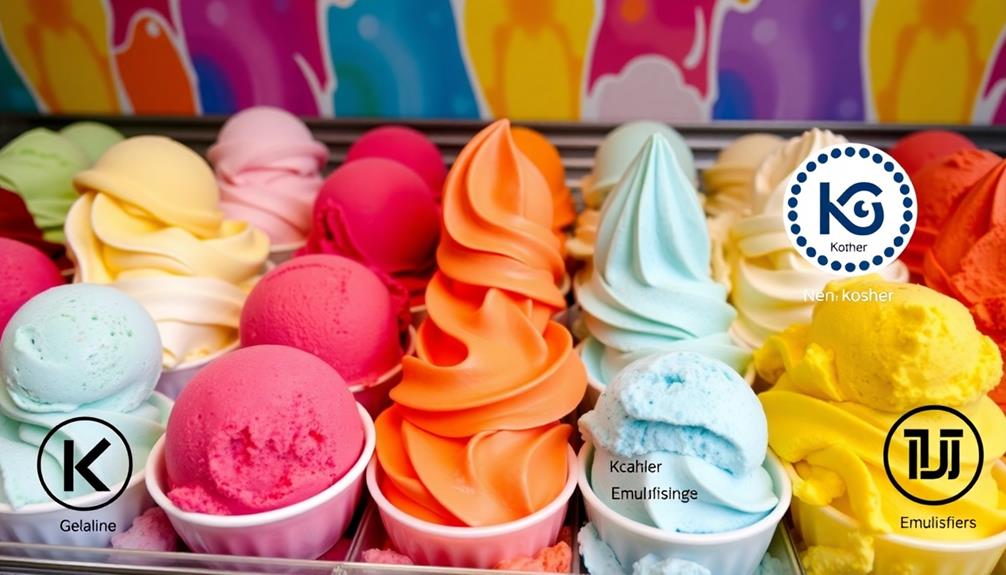
Maneuvering the world of ice cream can be tricky, especially when it comes to identifying common non-kosher ingredients that might sneak into your favorite flavors. Knowing these ingredients can help you make informed choices and avoid any surprises.
Here are some common non-kosher ingredients to watch out for:
- Stabilizers and Emulsifiers: Many are derived from animal sources that don't meet kosher standards. Always check the label.
- Flavorings: Some vanilla extracts may contain non-kosher alcohol or additives. Make sure to verify their kosher status.
- Gelatin: Frequently used as a thickening agent, gelatin is typically non-kosher unless sourced from kosher-certified animals and processed under strict supervision.
- Colorings and Preservatives: Some can be derived from non-kosher animals. It's important to check their kosher certification before consumption.
Kashrut Education Resources
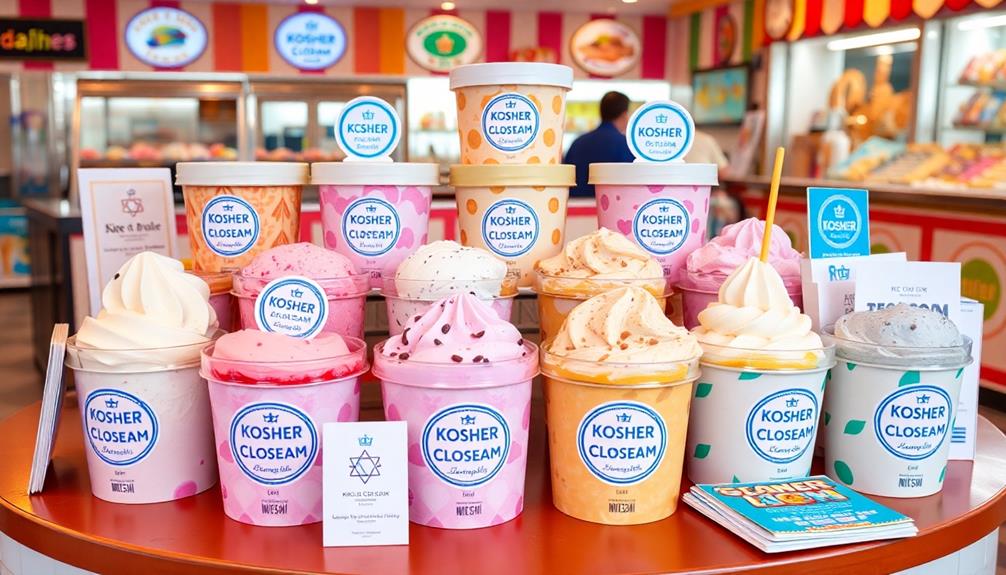
Understanding the complexities of kosher ingredients is just the beginning; education about Kashrut plays an essential role in making informed choices. The Orthodox Union (OU) provides various educational programs tailored to different demographics, ensuring that everyone can engage with the principles of Kashrut. Their workshops and seminars cover a range of topics, from the basics of kosher laws to more intricate discussions.
During the summer, immersive education programs focus on daily applications of Kashrut, allowing participants to experience hands-on kosher food preparation. These community initiatives aim to enhance your understanding of dietary laws and kosher certification, making it easier for you to navigate your choices.
OU also offers special workshops specifically designed for women, addressing unique aspects of Kashrut that pertain to food preparation and family traditions.
To further support your learning, educational resources and materials are readily available, helping you grasp the significance of kosher certification symbols and the importance of adhering to Kashrut principles. By taking advantage of these resources, you can deepen your knowledge and make more informed decisions in your kosher lifestyle.
Role of Certification Authorities
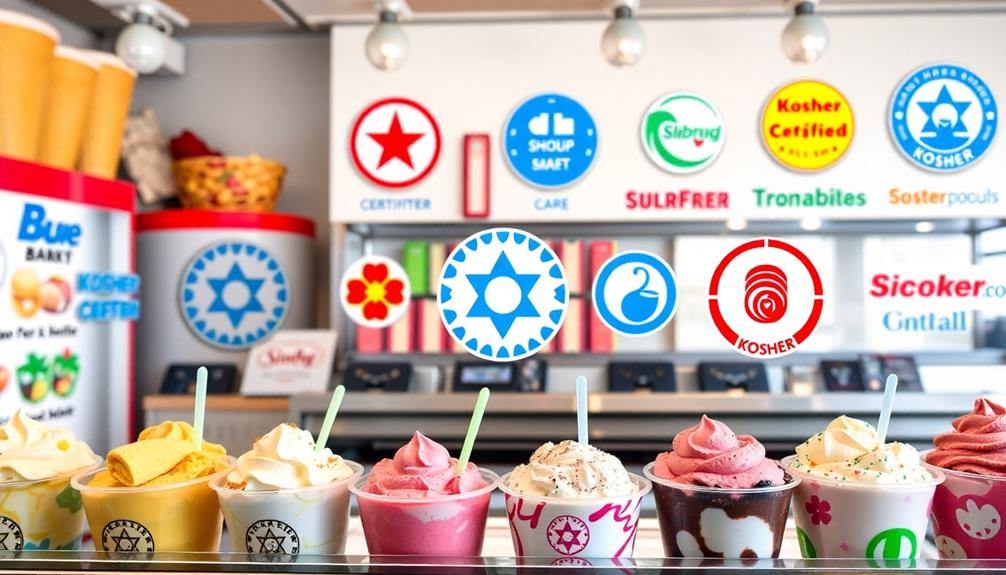
Verifying the kosher status of ice cream relies heavily on the role of certification authorities. These organizations, like the Orthodox Union (OU) and OK Kosher, are essential in confirming that ice cream products comply with Jewish dietary laws, known as kashrut.
Here's how they operate:
- Ingredient Inspection: Certification authorities meticulously check all ingredients to guarantee they meet kosher standards.
- Production Oversight: They inspect production processes to prevent any cross-contamination with non-kosher items.
- Regular Audits: Authorities conduct ongoing audits and inspections, maintaining compliance with kosher guidelines.
- Rabbinic Support: A Rabbinic Coordinator (RC) is often assigned to assist manufacturers, providing guidance throughout the certification process.
Without proper certification, ice cream risks containing non-kosher ingredients, which can undermine its integrity.
Reliable kosher certification symbols, like OU, OK, and Star-K, help you easily identify products that adhere to these standards.
Frequently Asked Questions
What Does It Mean When Ice Cream Is Kosher Certified?
When ice cream's kosher certified, it means all ingredients meet Jewish dietary laws. You'll find no non-kosher additives, and production follows strict guidelines, ensuring everything's from kosher sources and free from cross-contamination.
Which Ice Cream Brand Is Kosher?
When you're looking for kosher ice cream, check out brands like Ben & Jerry's, Haagen-Dazs, So Delicious, Dreyer's/Edy's, and Gelato Fiasco. They all offer delicious options that meet kosher certification standards. Enjoy!
Are All Kosher Certifications the Same?
No, not all kosher certifications are the same. Different certifying agencies have varying standards and practices. You should check symbols like OU or OK to guarantee they meet your personal kosher requirements.
What Makes a Product Certified Kosher?
Imagine you're enjoying a meal, wanting it to be kosher. A product's certified kosher when it follows Jewish dietary laws, uses approved ingredients, and displays certification symbols. Regular inspections guarantee it meets these standards consistently.
Conclusion
To sum up, enjoying kosher ice cream means knowing what to look for in certification and brands. Remember, "the proof of the pudding is in the eating," so always check for reliable kosher symbols before indulging. With a variety of delicious options available, you can satisfy your sweet tooth while staying true to your dietary beliefs. Embrace the joy of kosher treats, and don't hesitate to explore new flavors that align with your values!









